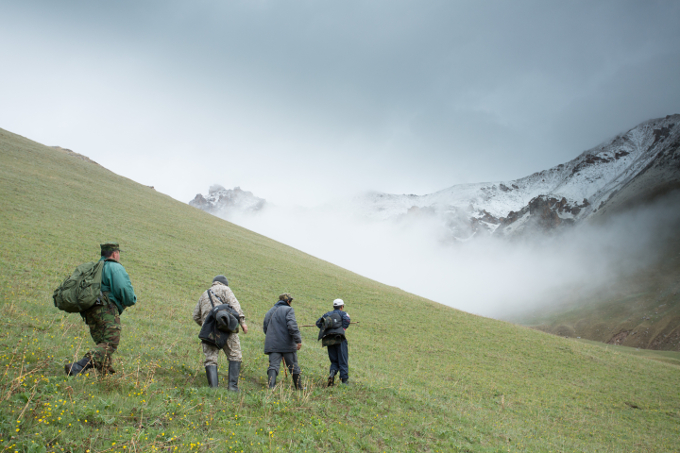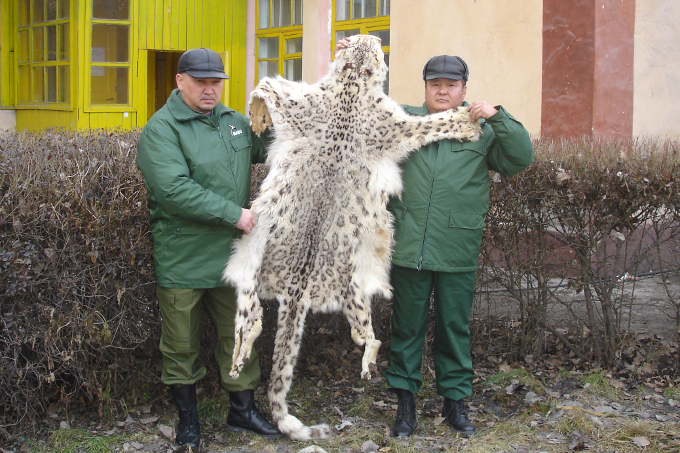Snow leopards are among the most endangered big cats on earth. Only 4,000 to 6,400 animals now live in the wild - photo: Andy Fabian
Protecting snow leopards
Wild, beautiful and endangered

Snow leopards are the only big cats that cannot roar - photo: Andy Fabian
Snow leopards are among the most endangered big cats on earth. In Kyrgyzstan, where some 1,400 animals roamed the mountain ranges in the 1980s, only about 250 snow leopards are estimated to live in the country today. Although poaching has long been forbidden by law, they are still ruthlessly hunted and their habitat continues to be encroached upon by humans.
NABU's commitment to the protection of big cats in Kyrgyzstan goes back to the '90s. Since 1999, the antipoacher unit "Gruppa Bars" in Kyrgyzstan is taking action against poaching and illegal trade, and various environmental education programmes are contributing to raising awareness. "Gruppa Bars" has already confiscated scores of snow leopard skins and bones and freed living snow leopards from foothold traps. Dozens of poachers have been arrested and convicted. In the patrol area of the "Gruppa Bars", poaching has declined significantly. Together with the Kyrgyz government, NABU is also working on recording data on snow leopards nationwide and agreeing on transnational protective measures at the Snow Leopard Conference.
NABU has now extended its commitment to the protection of snow leopards to Tajikistan, Pakistan and Nepal, where the association is working with partner organisations on a community-oriented basis and is working to prevent human-animal conflicts. The goal is to improve the image of the snow leopards, for example through burglar-proof stables for domestic animal herds and an insurance system for cattle ranchers.
NABU commitment to the snow leopard at these levels
➣ In Kyrgyzstan a specially trained anti-poaching unit, the "Gruppa Bars", puts a stop to poachers
➣ Injured animals are cared for in a new rehabilitation centre in Suluu-Terek
➣ In the local communities, environmental education ensures the necessary acceptance
➣ We help to improve the management of protected areas and pastures
➣ Monitoring work contributes to the study of snow leopards
-
-
The ranger group “Gruppa Bars“ on the road in the mountains. The antipoacher unit is taking action against poaching and illegal trade - photo: NABU/ Klemens Karkow
-
The work of the “Gruppa Bars“ is proving successful: with their help, more than 70 skins and several hundred weapons and traps have been confiscated - photo: NABU
-
A traditional yurt next to the environmental education centre in Kyrgyzstan, which was opened in 2018 - photo: UINI/ NABU
-
You can only protect what you know well. As part of its monitoring work, NABU employees setting up a photo trap in Kyrgyzstan - photo: Klemens Karkow
-
Since 2013, NABU has been helping to determine the size of the snow leopard population in Kyrgyzstan and to test the effectiveness of protection efforts - photo: NABU
-
The snow leopard has many fans in Kyrgyzstan: Flashmob in Bishkek on the International Snow Leopard Day 2018 - photo: NABU
-
NABU staff member Nurzat Iskakova. Through environmental education, we are doing educational work with cattle herders, pupils and the local population - photo: NABU
-
Participants of the second snow leopard summit which took place in Bishkek in 2017 - photo: NABU/ Johanna Huth
-
In 2020, former Kyrgyz Ambassador Erines Otorbaev receives the Snow Leopard Award for his extraordinary contribution to the endangered big cat - photo: NABU/ Marco Philippi
more
A new study demonstrates the encouraging upward trend of the snow leopard population in Kyrgyzstan since 2000. This study, conducted by the Global Snow Leopard and Ecosystem Protection Program, was carried out with the help of NABU Kyrgyzstan. more →
In Nepal's Nar Phu Valley, conflicts often arise between snow leopards and people. While livestock owners fear for their livelihoods, snow leopards suffer under revenge killings. A project searches for ways to foster a peaceful coexistence between the species. more →
Mountains inspire and challenge us. Their biodiverse and fragile ecosystems provide indispensable services to humanity. However, these regions are vulnerable to the impact of the climate crisis and land use. NABU works tirelessly to protect these landscapes. more →
Mountains, deserts, rainforests: Asia has an incredible range of ecosystems and species in need of conservation. In Central Asia, NABU has been active on the ground since the 1990s. In Southeast Asia, NABU and its partners focus on protecting and restoring rainforests in Sumatra and Sulawesi. more →
NABU realises its project „Sustainable yak husbandry in the Kyrgyz Tien Shan Mountains” as part of the Federal Environment Ministry's Advisory Assistance Programme in Middle and Eastern Europe states, Caucasus and Central Asia. more →
















